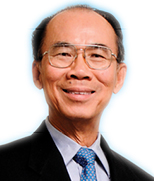
Interview with Tan Gee Paw, Chairman, PUB, Singapore's National Water Agency
Sharon Khoo, World Scientific
 r Tan Gee Paw has been Chairman of PUB, Singapore's national water agency, since 2001. He has been instrumental in ensuring the sustainability of Singapore's water supply through the diversification of Singapore's water sources. He was also responsible for drawing up the master plan and chairing the inter-agency committee to clean up the Singapore River and was conferred the Clean Rivers Commemorative Gold Medal in 1987 for his efforts. In 2007, he led PUB to win the Stockholm Industry Water Award, one of the highest accolades for outstanding achievements in the global water arena. r Tan Gee Paw has been Chairman of PUB, Singapore's national water agency, since 2001. He has been instrumental in ensuring the sustainability of Singapore's water supply through the diversification of Singapore's water sources. He was also responsible for drawing up the master plan and chairing the inter-agency committee to clean up the Singapore River and was conferred the Clean Rivers Commemorative Gold Medal in 1987 for his efforts. In 2007, he led PUB to win the Stockholm Industry Water Award, one of the highest accolades for outstanding achievements in the global water arena.
His long career includes years of service in the Public Works Department (PWD) and the then Ministry of the Environment. Prior to becoming Chairman of PUB, he was the Permanent Secretary (Environment) from 1995 to 2001. Mr Tan was conferred the Meritorious Service Medal (2001) for his work as Permanent Secretary of the then Ministry of the Environment, the President's Award for the Environment (2007) and the Distinguished Service Order (2010) for his work as Chairman of PUB.
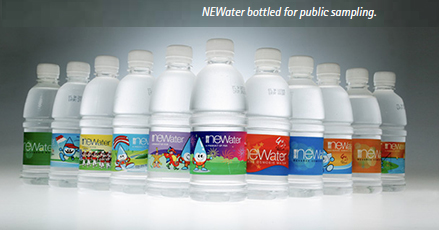 He shares some of his thoughts about the role of water in urban sustainability with Innovation Magazine. He shares some of his thoughts about the role of water in urban sustainability with Innovation Magazine.
i: What are your views on the part water plays in urban sustainability?
TGP: For a sustainable urban environment, it's not just clean water that is needed; it's also the waste water that needs to be cleaned up. Basically, an urban environment is not sustainable if the population goes down with waterborne diseases and epidemics a few times a year. People will be scared to go to your city because of all these issues. Clean water is critical because waterborne diseases used to wipe out the whole community in the ages past. We therefore need to ensure two things: first, that clean, potable water is supplied and can be drunk without the worry of getting sick; and second, that the waste water generated is properly collected, treated and disposed of. You can't have a city depending on, say, nightsoil buckets. Neither can we have a city where all the faeces and waste water goes into the drains when the toilet is flushed. In many countries, the waste goes into a small tank at the back of the building and then it goes back into the river or canal. For a sustainable city, that is unthinkable, especially one as densely populated as Singapore. Such a system is just not feasible or liveable. So that's the first critical factor for urban sustainability.
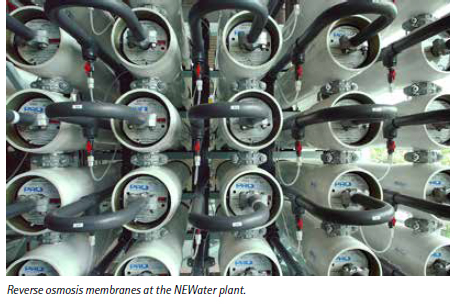 Second, of course, is the solid waste that is generated; that has also to be disposed of properly. In some cities, sanitary landfills or dumping grounds are used; the rains come and the waste all goes back to the water. That's why we are very careful about solid waste in Singapore - it must be collected every day because we are in the tropics. We can't keep it for two or three days or else we'll have flies and rats all over the place. It has to be removed from the houses and commercial premises every day and then disposed of safely. That's why we have incineration plants and a landfill on an offshore island. There's a lot of work that has to be done to keep the water sources clean to ensure the population's good health. So basically, it's an issue of environmental public health, and at the centre of it is water. If you want a sustainable urban environment, water is critical. Many countries now understand this, but the question is how to go about getting it done. Second, of course, is the solid waste that is generated; that has also to be disposed of properly. In some cities, sanitary landfills or dumping grounds are used; the rains come and the waste all goes back to the water. That's why we are very careful about solid waste in Singapore - it must be collected every day because we are in the tropics. We can't keep it for two or three days or else we'll have flies and rats all over the place. It has to be removed from the houses and commercial premises every day and then disposed of safely. That's why we have incineration plants and a landfill on an offshore island. There's a lot of work that has to be done to keep the water sources clean to ensure the population's good health. So basically, it's an issue of environmental public health, and at the centre of it is water. If you want a sustainable urban environment, water is critical. Many countries now understand this, but the question is how to go about getting it done.
i: You have been intimately involved in Singapore's water provision for nearly four decades. Over this period, what were the greatest challenges that Singapore faced in terms of water supply? How have they been overcome?
TGP: The greatest challenge, as we discovered in the 1960s and 1970s, was this: there just wasn't enough rainfall captured in our reservoirs for our growing population and industries. Therefore, the first thing we had to do was to capture as much of the rainfall as we could, even though we knew that, ultimately, it wouldn't be sufficient. That was our first challenge, and we went all out to develop our reservoirs as well as clean all our urban areas and convert them into water catchments. That was a massive program, which included a sewerage program, solid waste collection, and resettlement of squatters into the housing board areas, a whole-of-government approach. You can't have squatter colonies, people using overhanging latrines (latrines that overhung rivers because there was no sewerage system), and rubbish all over the place - you just can't use that water. Water was one of the critical factors so it was utterly important that we cleaned up and used as much of the rainfall as we possibly could.
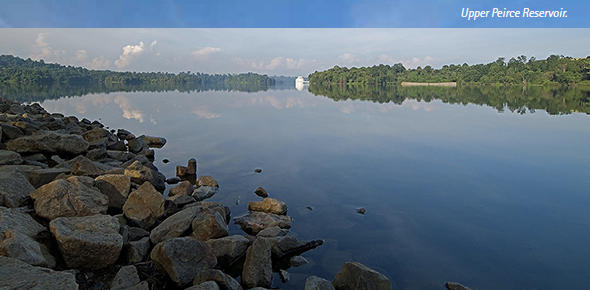 The next challenge was to supplement it. The best way was to reuse the water again and again. That's where technology came in. We didn't invent Newater; the technology had been around for more than a decade, mainly in the medical field. We were waiting for a breakthrough. We had to wait until such a time when membranes could be much cheaper and more reliable before it became feasible. Prior to that, we were following the developments in other parts of the world like the USA and so on, so we were behind them, just watching them. Then we noticed that the time had come when we could have a breakthrough. Indeed, the first breakthrough came here in Singapore, and we overtook them all. So that was water reuse, which is critical. The next challenge was to supplement it. The best way was to reuse the water again and again. That's where technology came in. We didn't invent Newater; the technology had been around for more than a decade, mainly in the medical field. We were waiting for a breakthrough. We had to wait until such a time when membranes could be much cheaper and more reliable before it became feasible. Prior to that, we were following the developments in other parts of the world like the USA and so on, so we were behind them, just watching them. Then we noticed that the time had come when we could have a breakthrough. Indeed, the first breakthrough came here in Singapore, and we overtook them all. So that was water reuse, which is critical.
But water reuse still depended on having the first drop of water before we could reuse it. That first drop of water was still critical. The issue would arise in times of drought. We needed to supplement that first drop of water with other sources of water, and sea water desalting was the only available source. In the early days, sea water desalting was extremely expensive because of the high energy requirements and so on, and there needed to be more membrane R&D. I think we were the first country to have a membrane desalting plant, and that was a breakthrough. So now we can supplement the first drop of water with desalted seawater, and of course, we can recycle the water again and again. With these two, we have finally overcome the water limitation which was a critical strategic factor for Singapore.
i: What do you see as the greatest challenge facing Singapore's water supply today and in the future? How can they be resolved?
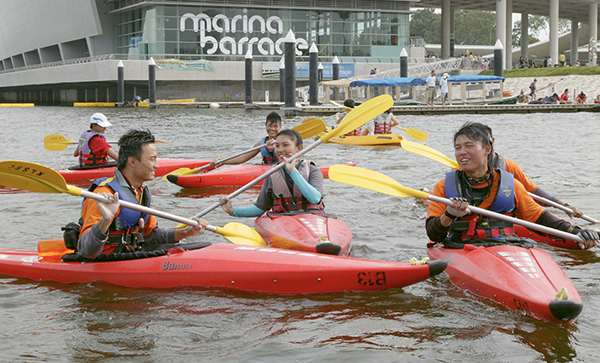 TGP: So far, I've been speaking about the supply side. We need to go to the demand side because if the demand side is a runaway issue, then we will be chasing our own tail all the time. So we need to study the demand for water carefully and try to reduce it as much as we can. The main issue that we fear is complacency: people saying, "Well, now we've got all these sources, why save water/" and the future generations becoming more lax in terms of the "save water" mindset. When we grew up in the 1960s and 1970s, we all knew that water was critical so the instinct to save water was always there. In those days, we didn't need public education - when a drought came, everybody knew there was not enough water. Today, we have to use public education to impress upon the population the need to reduce the usage of water. I think we are still using too much water per capita. We've got to cut it down. Basically, the greatest challenge is complacency in the population. Within the supplier, the PUB itself, we must also guard against complacency in the years to come. We must always be on our toes to make sure there is always enough supply to meet the rising demand. TGP: So far, I've been speaking about the supply side. We need to go to the demand side because if the demand side is a runaway issue, then we will be chasing our own tail all the time. So we need to study the demand for water carefully and try to reduce it as much as we can. The main issue that we fear is complacency: people saying, "Well, now we've got all these sources, why save water/" and the future generations becoming more lax in terms of the "save water" mindset. When we grew up in the 1960s and 1970s, we all knew that water was critical so the instinct to save water was always there. In those days, we didn't need public education - when a drought came, everybody knew there was not enough water. Today, we have to use public education to impress upon the population the need to reduce the usage of water. I think we are still using too much water per capita. We've got to cut it down. Basically, the greatest challenge is complacency in the population. Within the supplier, the PUB itself, we must also guard against complacency in the years to come. We must always be on our toes to make sure there is always enough supply to meet the rising demand.
i: You have been called the "Master Architect" of Singapore's water supply. What gives you the greatest satisfaction when you look back over your long and illustrious career?
TGP: I wouldn't call myself the "Master Architect"! The greatest satisfaction is simply this: that once you turn on the tap, there's water that is potable. Kids can drink the water from the tap, and mothers can use the water to feed their children. They don't have to depend on bottled water. It's not three hours a day; it's all day long. You use it for just a few seconds and it goes into the sewer. When you flush the toilet, everything goes. It's something quite amazing. These simple provisions for a modern lifestyle need a proper infrastructure for water supply and waste water disposal — billions of dollars spent. Of course, the most memorable day was the day we got rid of the nightsoil buckets. That was something - when we completed bringing sewers into every house in Chinatown and the city.
i: When was that?
TGP: It was in the 1980s, as late as that. And we celebrated the last nightsoil bucket that was collected. It was a memorable day. Lee Kuan Yew said, “Now we can leave the poverty of the past." That was a very telling statement. That was the day we knew we had sewered the entire island.
i: You are a painter, and many of your paintings feature some water. Were you always fascinated by water? Or was it because of your work that you became fascinated with water?
TGP: It's the first way. Since I was young, I've always been fascinated with water, water scenery and so on. That attracted me to work on water. There's nothing like sitting next to a reservoir or river and seeing clean water and beautiful landscapes - it soothes the heart.
i: When you started your career in PWD, was it with water?
TGP: Yes, it was with water — drainage. So I knew every drain and every canal in Singapore. Almost my whole career in the environment sector has involved water. Water has that special attraction for me.
 Click here to download the full issue for USD 6.50 Click here to download the full issue for USD 6.50
|



 r Tan Gee Paw has been Chairman of PUB, Singapore's national water agency, since 2001. He has been instrumental in ensuring the sustainability of Singapore's water supply through the diversification of Singapore's water sources. He was also responsible for drawing up the master plan and chairing the inter-agency committee to clean up the Singapore River and was conferred the Clean Rivers Commemorative Gold Medal in 1987 for his efforts. In 2007, he led PUB to win the Stockholm Industry Water Award, one of the highest accolades for outstanding achievements in the global water arena.
r Tan Gee Paw has been Chairman of PUB, Singapore's national water agency, since 2001. He has been instrumental in ensuring the sustainability of Singapore's water supply through the diversification of Singapore's water sources. He was also responsible for drawing up the master plan and chairing the inter-agency committee to clean up the Singapore River and was conferred the Clean Rivers Commemorative Gold Medal in 1987 for his efforts. In 2007, he led PUB to win the Stockholm Industry Water Award, one of the highest accolades for outstanding achievements in the global water arena.
 He shares some of his thoughts about the role of water in urban sustainability with Innovation Magazine.
He shares some of his thoughts about the role of water in urban sustainability with Innovation Magazine.
 Second, of course, is the solid waste that is generated; that has also to be disposed of properly. In some cities, sanitary landfills or dumping grounds are used; the rains come and the waste all goes back to the water. That's why we are very careful about solid waste in Singapore - it must be collected every day because we are in the tropics. We can't keep it for two or three days or else we'll have flies and rats all over the place. It has to be removed from the houses and commercial premises every day and then disposed of safely. That's why we have incineration plants and a landfill on an offshore island. There's a lot of work that has to be done to keep the water sources clean to ensure the population's good health. So basically, it's an issue of environmental public health, and at the centre of it is water. If you want a sustainable urban environment, water is critical. Many countries now understand this, but the question is how to go about getting it done.
Second, of course, is the solid waste that is generated; that has also to be disposed of properly. In some cities, sanitary landfills or dumping grounds are used; the rains come and the waste all goes back to the water. That's why we are very careful about solid waste in Singapore - it must be collected every day because we are in the tropics. We can't keep it for two or three days or else we'll have flies and rats all over the place. It has to be removed from the houses and commercial premises every day and then disposed of safely. That's why we have incineration plants and a landfill on an offshore island. There's a lot of work that has to be done to keep the water sources clean to ensure the population's good health. So basically, it's an issue of environmental public health, and at the centre of it is water. If you want a sustainable urban environment, water is critical. Many countries now understand this, but the question is how to go about getting it done.
 The next challenge was to supplement it. The best way was to reuse the water again and again. That's where technology came in. We didn't invent Newater; the technology had been around for more than a decade, mainly in the medical field. We were waiting for a breakthrough. We had to wait until such a time when membranes could be much cheaper and more reliable before it became feasible. Prior to that, we were following the developments in other parts of the world like the USA and so on, so we were behind them, just watching them. Then we noticed that the time had come when we could have a breakthrough. Indeed, the first breakthrough came here in Singapore, and we overtook them all. So that was water reuse, which is critical.
The next challenge was to supplement it. The best way was to reuse the water again and again. That's where technology came in. We didn't invent Newater; the technology had been around for more than a decade, mainly in the medical field. We were waiting for a breakthrough. We had to wait until such a time when membranes could be much cheaper and more reliable before it became feasible. Prior to that, we were following the developments in other parts of the world like the USA and so on, so we were behind them, just watching them. Then we noticed that the time had come when we could have a breakthrough. Indeed, the first breakthrough came here in Singapore, and we overtook them all. So that was water reuse, which is critical.
 TGP: So far, I've been speaking about the supply side. We need to go to the demand side because if the demand side is a runaway issue, then we will be chasing our own tail all the time. So we need to study the demand for water carefully and try to reduce it as much as we can. The main issue that we fear is complacency: people saying, "Well, now we've got all these sources, why save water/" and the future generations becoming more lax in terms of the "save water" mindset. When we grew up in the 1960s and 1970s, we all knew that water was critical so the instinct to save water was always there. In those days, we didn't need public education - when a drought came, everybody knew there was not enough water. Today, we have to use public education to impress upon the population the need to reduce the usage of water. I think we are still using too much water per capita. We've got to cut it down. Basically, the greatest challenge is complacency in the population. Within the supplier, the PUB itself, we must also guard against complacency in the years to come. We must always be on our toes to make sure there is always enough supply to meet the rising demand.
TGP: So far, I've been speaking about the supply side. We need to go to the demand side because if the demand side is a runaway issue, then we will be chasing our own tail all the time. So we need to study the demand for water carefully and try to reduce it as much as we can. The main issue that we fear is complacency: people saying, "Well, now we've got all these sources, why save water/" and the future generations becoming more lax in terms of the "save water" mindset. When we grew up in the 1960s and 1970s, we all knew that water was critical so the instinct to save water was always there. In those days, we didn't need public education - when a drought came, everybody knew there was not enough water. Today, we have to use public education to impress upon the population the need to reduce the usage of water. I think we are still using too much water per capita. We've got to cut it down. Basically, the greatest challenge is complacency in the population. Within the supplier, the PUB itself, we must also guard against complacency in the years to come. We must always be on our toes to make sure there is always enough supply to meet the rising demand.
 Click here to download the full issue for USD 6.50
Click here to download the full issue for USD 6.50